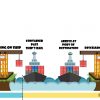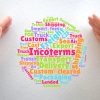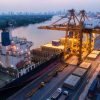This post is also available in:
 English
English  ไทย
ไทย

It is Incoterms that you must understand as long as you are a person who works not only in forwarders but also in the logistics department of manufacturers and trading companies. There are 11 items in Incoterms, but this time I would like to explain the 6 items used frequently.
Contents
Animation Movie – 6 Basic INCOTERMS
What is Incoterms?
 Incoterms is the definition of trade terms negotiated by the International Chamber of Committee. In trade transactions, the seller and buyer must firmly agree on conditions such as fare, insurance premiums and risk burden. This must not be inconsistent depending on the language and the countries so that we use internationally unified trading conditions called Incoterms.
Incoterms is the definition of trade terms negotiated by the International Chamber of Committee. In trade transactions, the seller and buyer must firmly agree on conditions such as fare, insurance premiums and risk burden. This must not be inconsistent depending on the language and the countries so that we use internationally unified trading conditions called Incoterms.
To explain it very briefly
· Which parts of logistics fare that Seller and Buyer have to pay
· Where is the responsibility of the shipping cargo transferred from the seller to the buyer
Incoterms is a term that anyone can recognize commonly in international transactions. Let’s explain the Incoterms which are frequently used one by one.
EXW (Ex Works)

EXW is to pass the completed cargo at the factory to the buyer at the factory. It is a condition that the buyer bears all the expenses of the logistics such as the customs clearance fee, the sea freight, the port cost at origin and destination, the import customs clearance fee, the domestic transportation cost to the factory.
When the cargo leave the factory, the responsibility of the cargo will be handed over to the buyer. Sellers (factory side) are not responsible even if cargo is damaged due to an accident during transportation from factory to port, for example.
FOB (Free On Board)

When the cargo boards the ship, responsibility for the cargo is transferred to the buyer. The seller bears the transportation cost from the factory to port, the charges at the port and export custom clearance.
And the buyer side will bear the ocean freight, import customs clearance, various expenses of the port, transportation costs to the delivery destination.
For example, when a ship loaded with cargos stranded to cause damage to the cargo, or when the cargo falls into the sea, this is the responsibility of the buyer. Even if you ask the factory for payment of the compensation, the factory side does not have a responsibility to pay for it.
C&F (Cost and Freight)

The seller side will bear the transportation fee until the cargo arrives at the destination port. For example, when cargo is transported from Thailand to Japan by sea, the seller will bear the shipping fee until the cargo arrives at the port of Japan, and the buyer will bear the expenses, the import customs clearance at the port of Japan, the fare of the transportation to the destination. Also, the terms and conditions are sometimes called CFR.
CIF (Cost, Insurance and Freight)

Insurance (insurance) is added to C&F. The seller arrange the insurance for sea transportation.
DDU (Delivered Duty Unpaid)

Sellers will be responsible for all shipping costs and risks to the location designated by the buyer, but buyers will be responsible for paying import duties and VAT. It is a condition that the seller transports by Door to Door.
DDP (Delivered Duty Paid)

It is a condition that the seller bears all costs and risks up to the place designated by the buyer. The seller also pays Duty and VAT. Although DDP is said to have the biggest burden on the seller side, the seller puts the transportation cost on the product price as well and sometimes adds a profit to the transportation cost. Under this condition, the seller will be able to control all of the cost of logistics.
Summary
Since these six Incoterms are used most frequently, let’s understand and remember this first. Although it depends on the seller’s and buyer’s discussions if they use which shipping term(Incoterms), please be sure to remember because there is a big merit if you understand logistics firmly as knowledge.







